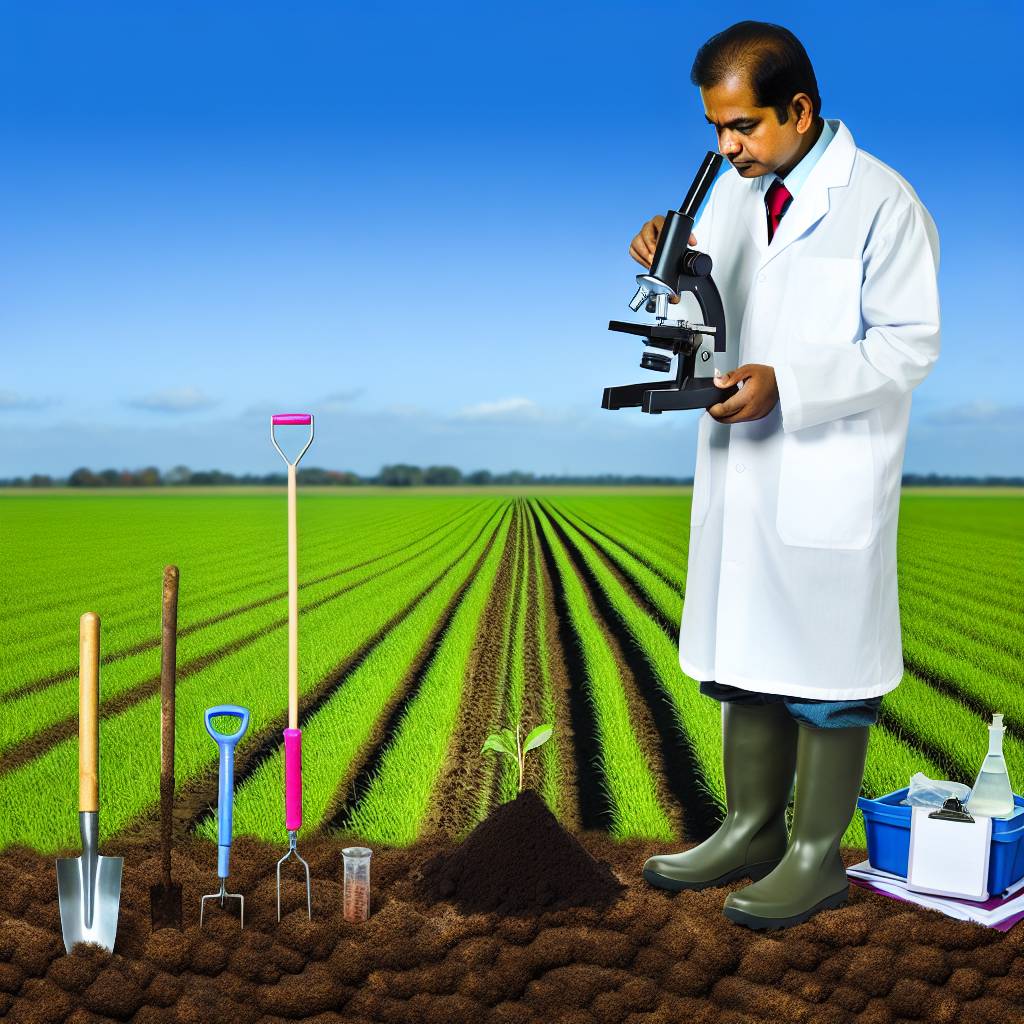Introduction to Soil-Borne Pathogens and Their Impact on Agriculture
Soil-borne pathogens pose significant threats to agricultural sustainability.
They negatively affect crop growth and overall farm health.
Farmers encounter challenges when combating these pathogens.
Consequently, addressing soil health is critical for maintaining productivity.
Understanding Soil-Borne Pathogens
Soil-borne pathogens include bacteria, fungi, viruses, and nematodes.
These pathogens thrive in the soil, impacting plants directly.
Infection often leads to reduced yields and crop failures.
Moreover, they can persist in the soil for extended periods.
Impact on Crop Production
Infected crops can exhibit symptoms such as wilting and stunting.
These symptoms ultimately lead to lower marketable yields.
As a result, farmers face financial losses and reduced profitability.
Additionally, the spread of pathogens can affect neighboring farms.
Long-Term Consequences for Farmland Value
Soil-borne pathogen problems can diminish farmland property values.
As crop yields decline, so does the attractiveness of the property.
Potential buyers often hesitate to invest in infected land.
Transform Your Agribusiness
Unlock your farm's potential with expert advice tailored to your needs. Get actionable steps that drive real results.
Get StartedThis hesitation can lead to long-term financial repercussions.
Strategies for Managing Soil-Borne Pathogens
Implementing effective management strategies is essential for farmers.
These strategies will help protect crops and enhance soil health.
Crop Rotation and Diversity
Practicing crop rotation disrupts pathogen life cycles.
Crop diversity also reduces pathogen pressures in the soil.
Consequently, both methods promote healthier ecosystems.
Soil Testing and Analysis
Regular soil testing helps identify specific pathogens present.
Understanding soil health fosters better decision-making for farmers.
This knowledge leads to targeted treatments and practices.
Utilizing Resistant Varieties
Planting disease-resistant crop varieties minimizes risks.
Farmers can choose cultivars that withstand specific pathogens.
Moreover, this strategy reduces reliance on chemical treatments.
Implementing Integrated Pest Management
Integrated pest management combines multiple strategies for effectiveness.
Farmers can incorporate biological controls, cultural practices, and resistant varieties.
This holistic approach helps manage soil-borne pathogens effectively.
Understanding Soil Health
Key Indicators of Soil Health
S oil health plays a vital role in agricultural productivity.
Key indicators include soil structure, organic matter, and nutrient levels.
These indicators reflect the overall condition of the soil.
Soil structure refers to how soil particles arrange themselves.
Healthy soil has a crumb-like structure that supports plant growth.
Additionally, organic matter enriches the soil with nutrients.
Nutrient levels indicate the availability of essential elements for crops.
Monitoring these indicators helps farmers manage their soil effectively.
Soil Testing Methods
Regular soil testing is a valuable practice for farmers.
Showcase Your Farming Business
Publish your professional farming services profile on our blog for a one-time fee of $200 and reach a dedicated audience of farmers and agribusiness owners.
Publish Your ProfileIt provides detailed information on soil nutrient content.
Farmers can choose from various testing methods based on their needs.
Laboratory testing offers a comprehensive analysis of soil samples.
On-site testing kits provide quick results for immediate decisions.
Both methods have their advantages and can complement each other.
Soil testing also helps identify any nutrient deficiencies.
Based on results, farmers can amend the soil appropriately.
Importance of Soil Health
Healthy soil contributes to sustainable farming practices.
It also helps reduce soil erosion and improves water retention.
Moreover, healthy soil supports biodiversity within the ecosystem.
Soil health enhances the resilience of crops against pests and diseases.
Farmers can achieve higher yields through improved soil health.
In turn, this results in better long-term farmland property value.
Investing in soil health is crucial for future agricultural success.
Common Soil-Borne Pathogens
Types of Soil-Borne Pathogens
Soil-borne pathogens vary widely in type and impact.
Fungi, bacteria, and nematodes are common examples.
These pathogens persist in the soil for years.
Different crops may be susceptible to different pathogens.
Understanding these types helps in prevention.
Fungal Pathogens
Fungal pathogens such as Fusarium and Rhizoctonia are prevalent.
Fusarium can cause root rot in many crops.
Symptoms include yellowing leaves and stunted growth.
Rhizoctonia leads to damping-off disease in seedlings.
Effective management is essential to protect against these fungi.
Bacterial Pathogens
Bacterial pathogens like Ralstonia and Erwinia also pose threats.
Ralstonia causes bacterial wilt in crops like tomatoes.
Symptoms include wilting and tissue browning.
It spreads through contaminated soil and water.
Erwinia can cause soft rot, affecting tubers and fruits.
Implementing crop rotation can help mitigate their effects.
Nematodes
Nematodes are microscopic worms causing significant crop damage.
Root-knot nematodes are particularly damaging.
Infested plants exhibit stunted growth and yellowing leaves.
They feed on plant roots, disrupting nutrient uptake.
Regular soil testing can help identify nematode presence.
Symptoms and Effects on Crops
Identifying symptoms early is crucial for control.
Symptoms often appear as wilting, yellowing, or stunted growth.
These signs indicate a potential soil-borne pathogen issue.
Infected crops may produce lower yields and quality.
Long-term, this affects farmland property value and ROI.
Showcase Your Farming Business
Publish your professional farming services profile on our blog for a one-time fee of $200 and reach a dedicated audience of farmers and agribusiness owners.
Publish Your ProfileImproving soil health can reduce pathogen prevalence.
Utilizing resistant crop varieties is also effective.
Incorporating organic matter can enhance soil vitality.
Practices like cover cropping promote healthy ecosystems.
Explore Further: Spotting Early Crop Infections For Higher US Farmland Investment Returns
Preventative Practices: Crop Rotation and Diversity for Soil Health
Understanding Crop Rotation
Crop rotation involves changing the crops grown in a specific area each season.
This practice can disrupt pest life cycles and reduce soil-borne pathogens.
Moreover, it enhances soil nutrients by alternating deep and shallow-rooted plants.
For instance, legumes can fix nitrogen in the soil, benefiting subsequent crops.
Farmers should plan rotations to maximize diversity and minimize disease risk.
The Benefits of Crop Diversity
Diverse cropping systems support beneficial insects and natural predators.
Additionally, they can improve soil structure and reduce erosion.
Furthermore, crop diversity can enhance resilience against extreme weather events.
This approach helps mitigate financial risks associated with monocultures.
Farmers often find that diverse crops yield better results over time.
Effective Crop Rotation Strategies
Implementing effective crop rotation requires careful planning and research.
Start by mapping out which crops thrive in your soil type and climate.
Consider incorporating cover crops during off-seasons to enhance soil health.
Regular soil testing helps track nutrient levels and pH balance.
Utilizing native plants can also support local ecosystems and biodiversity.
Integrating Cover Crops
Cover crops protect the soil during fallow periods by preventing erosion.
They also help suppress weeds and outcompete pathogens.
Further, these crops can enhance organic matter when tilled back into the soil.
Implementing cover crops can lead to improved economic returns in the long run.
Long-Term Strategies for Soil Health
The combination of crop rotation and diversity fosters long-term soil health.
Such practices not only mitigate pest risks but also enhance property values.
Investing in these methods pays off by supporting a sustainable farming future.
Explore Further: Crop Diversification Methods to Improve Farmland Value
Organic Amendments: Utilizing Compost and Biochar to Suppress Pathogens
Benefits of Compost in Soil Health
Compost improves soil structure and fertility.
It adds essential nutrients vital for plant growth.
Additionally, compost enhances soil moisture retention.
This organic amendment promotes beneficial microbial activity.
As a result, it helps suppress certain soil-borne pathogens.
Implementing Compost Effectively
To maximize benefits, apply compost evenly across fields.
Avoid over-application to prevent nutrient runoff.
Incorporate compost into the soil during tilling.
This method allows microbes to integrate effectively.
Role of Biochar in Soil Management
Biochar offers unique properties for soil health enhancement.
It improves soil aeration and drainage capabilities.
Moreover, biochar helps retain nutrients and reduce leaching.
Showcase Your Farming Business
Publish your professional farming services profile on our blog for a one-time fee of $200 and reach a dedicated audience of farmers and agribusiness owners.
Publish Your ProfileIts addition can significantly alter pH levels favorably.
Furthermore, biochar provides habitat for beneficial microorganisms.
Combining Compost and Biochar
Combining compost and biochar creates a synergistic effect.
This mixture improves soil nutrient cycling efficiency.
Additionally, it enhances carbon sequestration in soils.
Farmers can thus improve crop yield while suppressing pathogens.
Monitoring and Evaluation
Regularly monitor soil health indicators for best outcomes.
Test soil microorganisms to assess pathogen levels.
Adjust application rates based on soil test results.
This approach ensures effective pathogen suppression over time.
Uncover the Details: Greenhouse Leasing for Agricultural Property Owners

Integrated Pest Management Strategies for Soil-Borne Pathogens
Understanding Soil-Borne Pathogens
Soyl-borne pathogens can severely affect crop health.
They thrive in the soil, negatively impacting plant growth.
Common pathogens include fungi, bacteria, and nematodes.
Recognizing these threats is vital for effective management.
Implementing IPM Practices
Integrated Pest Management (IPM) provides a holistic approach.
It combines cultural, biological, and chemical strategies.
Firstly, assess the specific pathogens present in the soil.
Secondly, use disease-resistant crop varieties when possible.
Thirdly, apply crop rotation to disrupt pathogen life cycles.
Cultural Practices
Cultural practices play a significant role in IPM.
They include adjusting planting dates and soil management.
Additionally, proper irrigation helps prevent disease spread.
Taking care to minimize soil compaction improves drainage.
Biological Control
Biological control involves using natural enemies of pathogens.
For example, beneficial microbes can outcompete harmful ones.
Applying organic amendments can enhance soil health.
Moreover, encouraging biodiversity in the ecosystem is beneficial.
Chemical Controls
When necessary, chemical controls may be applied judiciously.
Fungicides can help manage soil-borne fungal infections.
Chemical treatments should complement other IPM strategies.
Always follow label instructions to minimize environmental impact.
Regular Monitoring and Evaluation
Monitoring is essential for effective IPM implementation.
Regular soil tests can help identify pathogen levels.
Additionally, observe plant health for early signs of disease.
Evaluate the effectiveness of all management practices.
Education and Training
Education is key to successful pest management.
Farmers should stay informed about current IPM practices.
Participating in workshops and seminars can enhance knowledge.
Collaboration with agricultural extension services is beneficial.
Showcase Your Farming Business
Publish your professional farming services profile on our blog for a one-time fee of $200 and reach a dedicated audience of farmers and agribusiness owners.
Publish Your ProfileFind Out More: Integrating Precision Agriculture With Real Estate Strategies For Crop Success
Technological Innovations: Soil Sensors and Monitoring Tools
Importance of Soil Monitoring
Soil monitoring plays a crucial role in sustainable agriculture.
It helps detect soil-borne pathogens early on.
Additionally, early detection prevents losses in crop yield.
Farmers can make data-driven decisions for better management.
Types of Soil Sensors
Various sensors exist to monitor soil health effectively.
Moisture sensors gauge water levels in the soil.
Nutrient sensors help analyze the presence of essential minerals.
Temperature sensors track changes affecting microbial activity.
Benefits of Soil Sensors
Soil sensors offer numerous advantages to farmers.
They provide real-time data for immediate decision-making.
Furthermore, they help optimize resource usage.
This leads to improved crop health and sustainability.
Integration with Digital Tools
Integrating soil sensors with digital platforms enhances analysis.
Farmers can visualize trends over time for better understanding.
Moreover, data integration allows for tailored soil management.
This ultimately boosts long-term farmland property value.
Case Studies of Successful Implementation
Many farmers have successfully adopted soil sensors.
For instance, Green Fields Farm utilized moisture sensors.
They noticed a 30% increase in crop yield after implementation.
This illustrates the effectiveness of technology in agriculture.
Future Trends in Soil Monitoring
The future of soil monitoring looks promising.
Advancements in sensor technology will enhance precision.
Additionally, AI and machine learning will offer deeper insights.
These developments will revolutionize farming practices.
Long-Term Benefits of Healthy Soil
Enhancing Soil Health
Healthy soil plays a crucial role in agriculture.
It improves crop yields and quality significantly.
Moreover, it fosters a robust ecosystem below the surface.
Beneficial microorganisms thrive in well-balanced soil.
This leads to better nutrient availability for plants.
Increasing Property Value
Investing in soil health can enhance farmland property values.
Healthy soils attract more potential buyers and investors.
Good soil management practices lead to higher resale values.
This trend is evident in various agricultural regions.
Reducing Long-Term Costs
Investing in soil health can lead to cost savings over time.
Healthy soil reduces the need for chemical fertilizers.
This decreases overall expenditure for farmers.
Additionally, less pesticide use minimizes environmental impact.
Economic Return on Investment
A focus on soil health can provide significant economic ROI.
Enhanced crop performance leads to increased income for farmers.
Showcase Your Farming Business
Publish your professional farming services profile on our blog for a one-time fee of $200 and reach a dedicated audience of farmers and agribusiness owners.
Publish Your ProfileLong-term investment in soil health pays off during tough seasons.
Farmers can rely on consistent yields year after year.
Building a Sustainable Future
Commitment to healthy soil benefits future generations.
It ensures the longevity of farmland and its productivity.
Sustainable practices help combat climate change effects.
Therefore, investing in soil health is a smart choice for any farmer.
Additional Resources
FY 19 Desciption of Funded Projects
Hydroponics: current trends in sustainable crop production – PMC




